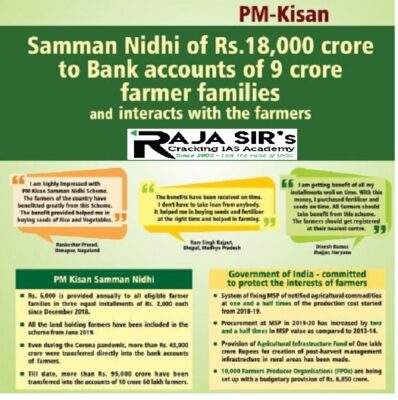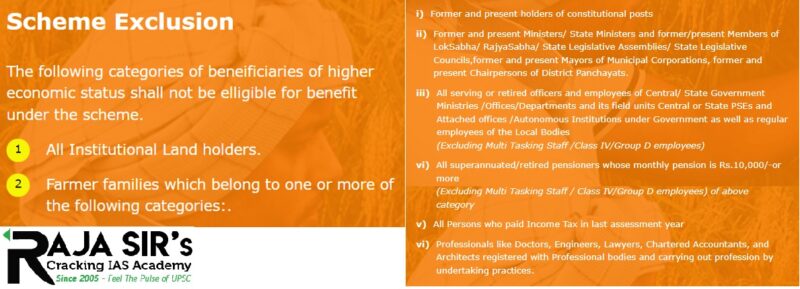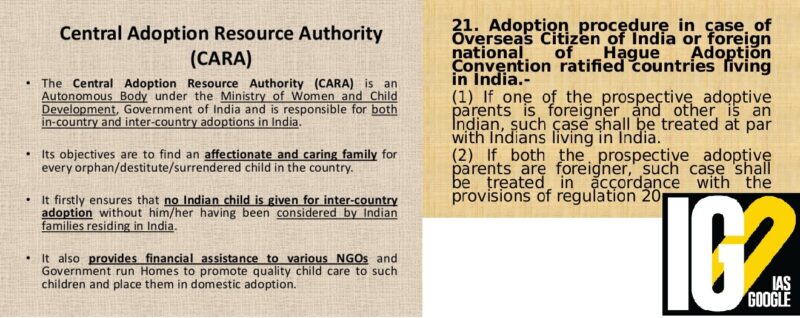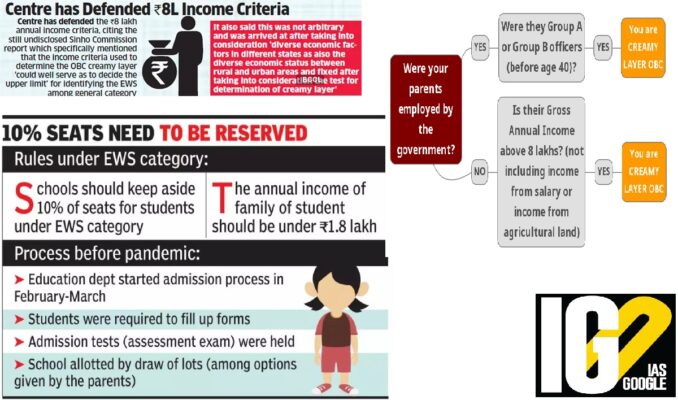- Home
- Prelims
- Mains
- Current Affairs
- Study Materials
- Test Series
 EDITORIALS & ARTICLES
EDITORIALS & ARTICLES
Jan 02, 2022
MINISTRY OF CIVIL AVIATION RELEASES DRAFT ‘NATIONAL AIR SPORTS POLICY’ FOR PUBLIC FEEDBACK
Recently, Ministry of Civil Aviation released draft National Air Sports Policy (NASP) for public feedback.
 National Air Sports Policy (NASP):
National Air Sports Policy (NASP):
 Pradhan Mantri Kisan Samman Nidhi (PM-KISAN)
Pradhan Mantri Kisan Samman Nidhi (PM-KISAN)
 36,000 COUPLES IN QUEUE, BUT CARA HAS 1,936 KIDS
The quarterly data analysis report released by the voluntary organization states that a total of 1,936 children were legally available with the Central Adoption Resource Authority (CARA).
36,000 COUPLES IN QUEUE, BUT CARA HAS 1,936 KIDS
The quarterly data analysis report released by the voluntary organization states that a total of 1,936 children were legally available with the Central Adoption Resource Authority (CARA).
 Central Adoption Resource Authority (CARA)
Central Adoption Resource Authority (CARA)
 Genesis:
Genesis:
 Medical termination of pregnancy (MTP) amendment act 2021
Medical termination of pregnancy (MTP) amendment act 2021
 National Air Sports Policy (NASP):
National Air Sports Policy (NASP):
- Governing body: Air Sports Federation of India (ASFI).
- Aim: To make India one of the top air sports nations by 2030.
- Promote an air sports culture in the country.
- Adopt international practices in safety including air sports infrastructure, equipment, operations, maintenance and training.
- Develop India as a preferred global hub for air sports.
- Enhance participation of Indian sportspersons in global air sports events.
- Promote design, development and manufacturing of air sports equipment in India in line with the Aatmanirbhar Bharat Abhiyan.
- NASP seeks to leverage India’s potential for air sports given its large geographical expanse, diverse topography and weather conditions.
- Coverage: covers sports like aerobatics, ballooning, drones, paragliding, micro lighting and paramotoring, skydiving etc.
- ASFI will be established as the apex governing body.
- Associations for each air sport will handle day to day activities e.g., Paragliding Association of India or Skydiving Association of India
- The associations shall be accountable to ASFI for providing safe, affordable, accessible and sustainable conduct of their respective air sport.
- ASFI shall represent India at Federation Aeronautique Internationale (FAI) and other global platforms related to air sports.
- All competitions in India will be conducted as per the guidelines laid down by FAI.
- FAI, headquartered in Lausanne, Switzerland is the world governing body for air sports.
- NASP focus on ensuring international practices in safety.
- Inability to enforce safety standards by an air sports association may lead to penal action by the ASFI including financial penalties, suspension or dismissal.
- All persons and entities providing air sports services shall be required to register as members of the respective air sports associations.
- An airspace map of India has been published on Directorate General of Civil Aviation (DGCA) Digital Sky Platform.
- The map in the platform segregates the entire airspace of India into red zone, yellow zone and green zone.
- Operation in red and yellow zones requires permission from Central Government and the concerned Air Traffic Control authority.
- Operation in green zones for aircraft with all-up weight up to 500 kg does not require any permission.
- The Government will consider, allowing import of air sports equipment without any import duty.
- Schools, colleges and universities will be encouraged to have air sports included in their curriculum.
- Long term funding for development of air sports in India shall come from corporate investors, membership fees, events and media rights.
- ASFI may seek financial support from Government of India for promotion of air sports.
- Government will focus on rationalizing the GST rate on air sports equipment to 5% or less.
 Pradhan Mantri Kisan Samman Nidhi (PM-KISAN)
Pradhan Mantri Kisan Samman Nidhi (PM-KISAN)
- PM Kisan is a Central Sector scheme with 100% funding from Government of India.
- It is a voluntary and contribution-based pension scheme.
- Aim: To supplement the financial needs of the small and marginal Farmers in procuring various inputs to ensure proper crop health and appropriate yields.
- Under the scheme an income support of 6,000/- per year in three equal instalments are provided to all land holding farmer families.
- State Government and UT administration will identify the farmer families which are eligible for support as per scheme guidelines.
- The fund will be directly transferred to the bank accounts of the beneficiaries.
- All landholding farmers' families, which have cultivable landholding in their names are eligible to get benefit under the scheme.
 36,000 COUPLES IN QUEUE, BUT CARA HAS 1,936 KIDS
The quarterly data analysis report released by the voluntary organization states that a total of 1,936 children were legally available with the Central Adoption Resource Authority (CARA).
36,000 COUPLES IN QUEUE, BUT CARA HAS 1,936 KIDS
The quarterly data analysis report released by the voluntary organization states that a total of 1,936 children were legally available with the Central Adoption Resource Authority (CARA).
 Central Adoption Resource Authority (CARA)
Central Adoption Resource Authority (CARA)
- CARA is a statutory body of the Ministry of Women & Child Development, Government of India.
- It functions as the nodal body for the adoption of Indian children and
- It is mandated to monitor and regulate in-country and inter-country adoptions.
- It is designated as the Central Authority to deal with inter-country adoptions following the provisions of the Hague Convention on Inter-country Adoption, 1993.
- It primarily deals with the adoption of orphan, abandoned, and surrendered children through its recognized adoption agencies.
- To promote & regulate In-country adoptions and to facilitate Inter-state adoptions in coordination with State Agency;
- To frame regulations on adoption and related matters from time to time as necessary.
- To carry out the functions of the Central Authority under the Hague Convention on Protection of Children and Cooperation in respect of Intercountry Adoption;
- Monitor and regulate the procedure for in-country adoption.
- Receive applications of a Non-Resident Indian or Overseas Citizens of India through an authorized adoption agency or Central Authority.
- Issue No Objection Certificate in all cases of inter-country adoptions.
- Intimate the immigration authorities of India and the receiving country of the child about the inter-country adoption cases.
- Conduct research, documentation, and publication on adoption and related
- Provide support and guidance to State Adoption Resource Agencies.
- Establish uniform standards and indicators, relating to:
- Adoption procedure related to the orphan abandoned and surrendered children and also related to relative adoptions.
- Quality child care standards in Specialised Adoption Agency and Child Care Institution.
- Monitoring and supervision of service providers.
- Standardization of documents in cases of adoptions.
- Safeguards and ethical practices including online applications for facilitating hassle-free adoptions.
 Genesis:
Genesis:
- The Supreme Court (SC) raised questions on Centre’s decision to raise the economically weaker sections (EWS) criteria limit to ₹8 lakh.
- SC also asked for clarification on Centre’s part on how it decided the limit of ₹8 lakh.
- The Union Government then decided to revisit the criteria set out for eligibility for its 10% reservation under the economically weaker sections (EWS) category.
- Ajay Bhushan Pandey Committee was setup to review the criteria.
- The committee recommended continuance of Rs 8 lakh income limit.
- The 10%reservation was introduced through the 103rd Constitution Amendment and enforced in January 2019.
- The EWS reservation bill (e., Constitution (124thAmendment) Bill, 2019) will be in addition to the existing reservation.
- It added Clause (6) to Article 15to empower the Government to introduce special provisions for the EWS.
- It allows reservation in educational institutions, both public and private, whether aided or unaided, excluding those run by minority institutions.
- It also added Clause (6) to Article 16 to facilitate reservation in employment.
- This quota applies to all those who;
- are not covered in the existing quotas.
- have family income below Rs. 8 lakh a year.
- Income from all sources such as salary, business, agriculture and profession for the financial year prior to the application.
- have agricultural land below 5 acres.
- has house below 1000 sq. ft.
- has a plot of 100 yard or below in a notified municipal area.
- has a plot a 200 yard or below in a non-notified municipal area.
- The states have the sole discretion to apply the quota in state run educational institutions and state government jobs.
- It violates the Basic Structure of the Constitution.
- The special protections guaranteed to socially disadvantaged groups are part of the Basic Structure and that the 103rdAmendment departs from this by promising special protections on the sole basis of economic status.
- It violates the Supreme Court’s 1992 ruling in Indra Sawhney & Others v Union of India, which upheld the Mandal Report and capped reservations at 50%.
- In the ruling, the court held that economic backwardness cannot be the sole criterion for identifying backward class
- The private, unaided educational institutions have argued that their fundamental right to practise a trade/profession is violated when the state compels them to implement its reservation policy and admit students on any criteria other than merit.
- The upper limit of income of Rs. 8 lakh per annum for being eligible for the quota is
- The per capita income or GDP in all States and the purchasing power in the rural and urban areas are different, while a single income limit is formulated for the whole country.
- Creamy layer is a term which refers to some members of a backward class who are highly advanced socially as well as economically and educationally.
- They constitute the forward section of that particular backward class.
- They are not eligible for government-sponsored educational and professional benefit programs.
- The term was introduced by the Sattanathan Commission in 1971, which directed that the "creamy layer" should be excluded from the reservations (quotas) of civil posts.
- It was also identified later by Justice Ram Nandan Committee in 1993.
- For those not in government, the current threshold is an income of Rs 8 lakh per year.
- For children of government employees, the threshold is based on their parents’ rank and not income.
- The income criterion for the EWS is much more stringent than the one for the OBC creamy layer.
- First, the EWS’s criteria relates to the financial year prior to the year of application whereas the income criterion for the creamy layer in OBC category is applicable to gross annual income for three consecutive years.
- Secondly, in case of deciding the OBC creamy layer, income from salaries, agriculture and traditional artisanal professions are excluded from the consideration whereas the Rs 8 lakh criteria for EWS includes that from all sources, including farming.
 Medical termination of pregnancy (MTP) amendment act 2021
Medical termination of pregnancy (MTP) amendment act 2021
- Aim: To access of women to safe and legal abortion services on therapeutic, eugenic, humanitarian or social grounds.
- Enhancing the upper gestation limit from 20 to 24 weeks for special categories of women which would include
- Survivors of rape
- Victims of incest
- Other vulnerable women (like differently-abled women, minors).
- Opinion of only one provider will be required up to 20 weeks of gestation and of two providers for termination of pregnancy of 20-24 weeks of gestation.
- Upper gestation limit not to apply in cases of substantial fetal abnormalities diagnosed by Medical Board.
- Name and other particulars of a woman whose pregnancy has been terminated shall not be revealed except to a person authorised in any law for the time being in force.
- The ground of failure of contraceptive has been extended to women and her partner.
- It increases the ambit and access of women to safe abortion services.









 Latest News
Latest News General Studies
General Studies